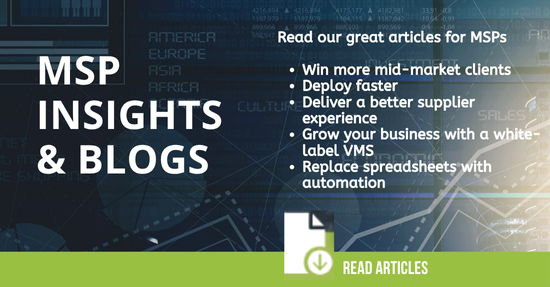Are you considering whether your company requires a VMS or an MSP to assist in managing your contingent workforce? This article examines the difference between a VMS and an MSP and how they can collaborate to enhance your contingent management program.
Are you still using manual spreadsheets?
Relying on manual spreadsheets for managing your contingent workforce can result in internal inefficiencies, lack of centralization, human errors, disjointed processes throughout your organization, and insufficient insights into vendor performance. This situation can lead to hidden costs, unapproved spending, and a total lack of transparency regarding your non-employee workforce and the performance of your staffing agencies.
You have the chance to tackle these issues with effective management solutions that provide your business with clear visibility and control over your vendors, resulting in enhanced workforce quality, reduced expenses, and ultimately, increased profits.
If you're just beginning, it's important to understand the distinction between an MSP and a VMS, and how they can work in tandem.
What is an MSP?
A managed services provider (MSP) is a company that assumes the responsibility of managing your entire non-employee workforce. This involves outsourcing the complete management of non-employee workers and staffing agencies to an external provider, rather than having it handled by your company’s HR or procurement department.
An MSP handles all aspects of managing your contingent workforce and staffing agencies, including sourcing workers, managing vendor relationships, evaluating vendor performance, processing payments, and more.
MSPs can be either vendor-neutral or not. Some managed services providers recruit contingent workers from their own pre-approved database of staffing agencies, while others do not have exclusive ties to specific staffing agencies.
What is a VMS?
A vendor management system, also referred to as vendor management software, is a web or cloud-based platform designed to help companies manage, automate, and centralize the oversight of their non-employee workforce in one place.
A VMS automates all tasks related to managing your contingent workforce and its vendors, covering essential processes like sourcing, onboarding, time tracking, approvals, payments, and more. This automation saves your organization significant time and greatly enhances internal efficiency.
Beyond automating these tasks, consolidating a non-employee workforce program provides strategic insights into its performance. It offers companies clear visibility into vendor performance, identifies areas of unauthorized spending within their non-employee workforce program, and assesses whether staffing agencies are meeting set targets.
To learn more, you can read:
- What is a VMS?
- How Does a Vendor Management System Work?
- What are the Benefits of a Vendor Management System?
VMS or MSP?
It's crucial to understand that an MSP and a VMS are not fundamentally different solutions; rather, they represent alternative approaches for managing your contingent workforce program. Utilizing a VMS internally simplifies the management process, whereas an MSP handles the process externally, allowing your internal resources to focus elsewhere.
MSPs need a VMS to manage your Contingent Workforce
If you are a larger company, it's likely you have a managed service provider. The managed services provider will use a vendor management system to manage your contingent workforce on your company’s behalf. In today's world, some MSP have an existing relationship with a VMS and in other situations, their client's may have their own VMS that the MSP will partner with. For many organizations an MSP brings extensive VMS experience, and could offer additional talent pools necessary for agile growth, along with strategic consulting.
To learn more, you can read: MSP vs VMS: What's the Difference?
Smaller Companies may choose to manage their workforce internally with a VMS
A VMS is often selected by organizations with smaller contingent workforce spend or who choose to manage their contingent workforce internally.
As an organization with smaller temporary staffing spend, anywhere over $3 MM - should have a VMS, can realize huge benefits from the implementation of a vendor management system without going the outsourced route.
Learn more about the Benefits of a VMS
Download our Free VMS Buyer's Guide
Why Organizations Choose Conexis VMS
Whether you're managing a mid-size contingent workforce program, supporting multiple clients across regions, or looking for a mid-market VMS to add to your offering, the right VMS can amplify your contingent workforce program and deliver real, measurable results.
We’ve built a VMS specifically for mid-market contingent workforce programs: simple to use, cost-effective, flexible, and fast to deploy. Our platform can be implemented in as little as a few weeks (not months), helping you deliver value to clients faster than ever before.
Discover the Power of Conexis VMS
Conexis VMS is purpose-built for organizations seeking to manage their contingent labor spend effectively. Here’s why we're the right choice:
- Fast Deployment: Get up and running in weeks, not months
- Transparent Pricing: Flexible pricing with no hidden costs
- White-Label Ready: Customize the platform with your brand
- Real-Time Insights: Make faster decisions with built-in analytics
- Audit-Ready Compliance: Store contracts, worker data, and rates in one secure hub
Contact Us
Whether you are looking to Switch your VMS, or just Getting Started, we are here to help. Contact Us for a Free No-Obligation Consultation, See how Easy Conexis is to use by taking a quick 2 minute Self-Guided Online Demo, or Book a Personal Demo Today!
Articles for Managed Service Providers
From ways to grow your business, to reducing cost, automating your program or delivering more value, read our library of articles for MSPs
MSP & VMS Partnership:
Why MSPs Need a VMS Partner, not just a Vendor
MSP and VMS Partnerships - How do they work together?
MSP vs VMS - What's the difference?
VMS Technology MSPs need
Open APIs - A Game Changer for MSPs
How to get open access & control of your own data with a VMS
Why MSPs need a more customizable VMS to be competitive
How Conexis with our Open APIs Delivered for our latest MSP Partner!
Growing your Business with a VMS
MSPs & Staffing Agencies: Grow your business with a White-Label VMS
Why MSPs need a Mid-Market VMS
Choosing the Best VMS for your MSP
MSPs: 5 Key Factors to Consider when choosing the Right VMS
Legacy vs Modern VMS - What's the Difference?
The 4 Key Features that define an Exceptional VMS for an MSP
Can I switch my VMS without switching my MSP?
MSP Conexis Case Study - Launching a VMS
MSP Conexis Case Study- How Open APIs delivered results
Moving from Spreadsheets to a VMS
6 Reasons to switch from spreadsheets to a vendor management system
Adding Value with a VMS
How MSPs can leverage VMS software to deliver higher ROI for Clients
MSPs - 3 Ways to Immediately add Value to your Client's CWF Programs





